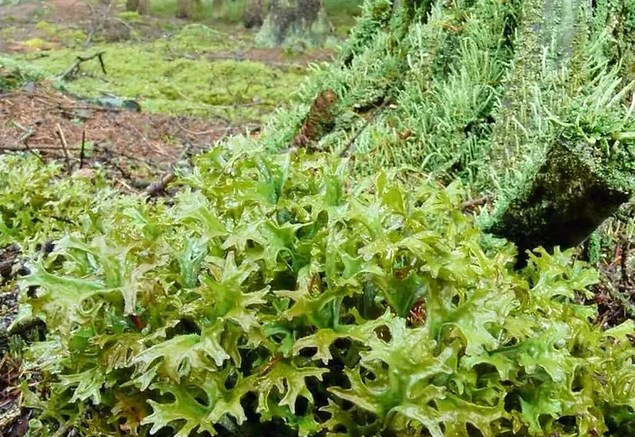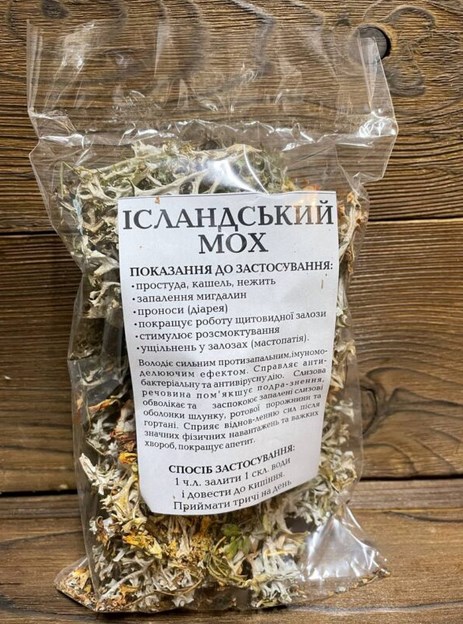- Fast
shipping - Fresh
flowers - Favourable
prices
Is Iceland moss a miracle cure? All answers to ProFlowers.ua
Icelandic moss (lat. Cetraria islandica) is a type of lichen that grows on rocks and soil in the northern regions of Europe, North America and Asia. This moss is one of the best known lichen species and is used in medicine and cosmetics. Iceland moss has been used since ancient times as a medicinal plant. It is used to treat diseases of the respiratory system, gastrointestinal tract and skin. It contains a rich set of useful substances such as polysaccharides, carbohydrates, proteins, fats and vitamins. In the cosmetics industry, Iceland moss is used as a natural ingredient in skin care. Its extract helps to moisturize and improve skin texture, as well as reduce inflammation and irritation.
Iceland moss is also widely used in the food industry. It is added to foods to give them flavor and aroma. In addition, this moss can be used as a substitute for dyes and flavors in food products. Finally, Iceland moss has a number of other uses. It is used as an absorbent for water purification, as well as for the production of herbal teas and tinctures. Iceland moss is used in traditional medicine to treat various ailments such as coughs, bronchitis, colds, sore throats, gastritis, stomach and duodenal ulcers, and to strengthen the immune system.

Iceland moss contains a rich array of nutrients such as polysaccharides, carbohydrates, proteins, fats and vitamins that can have a positive effect on the human body.
For example, the polysaccharides found in Icelandic moss may have immunomodulatory properties, ie. they can help strengthen the immune system and boost its defenses. In addition, Icelandic moss may have anti-inflammatory effects, which may be useful in the treatment of diseases of the respiratory system and gastrointestinal tract.
However, it should be noted that Iceland moss is not a miracle cure and cannot replace the full treatment recommended by a doctor. Before using Icelandic moss as a medicine, a qualified medical practitioner should be consulted.
Icelandic moss, what are the folk recipes?
Icelandic moss is widely used in traditional medicine and there are many folk recipes that use it to treat a variety of ailments. Here are some examples of folk recipes using Icelandic moss:
Iceland Moss with Honey and Lemon for Coughs and Colds: Mix 1 tablespoon of Icelandic moss, 2 tablespoons of honey, and the juice of half a lemon. Add hot water and stir. Drink this remedy as needed when cough and cold symptoms appear.
Iceland moss for gastritis and stomach ulcers: Mix 1 tablespoon of Iceland moss and 1 cup of cold water. Leave for a few hours until the moss swells. Then stir the mixture and drink half a glass 30 minutes before meals. This remedy helps reduce inflammation and irritation in the stomach, and also reduces acidity.
Iceland moss for skin problems: Pour 1 tablespoon of Iceland moss into 1 cup of boiling water and let steep for 15-20 minutes. Then mix the infusion with 1 tablespoon of olive oil and 1 teaspoon of honey. Apply the resulting mixture to problem areas of the skin and leave for 20-30 minutes, then rinse with water. This remedy helps soften and moisturize the skin, and can also reduce inflammation and irritation.
Iceland moss for bronchitis: Add 1 tablespoon of Iceland moss to 1 cup boiling water and let steep for 15-20 minutes. Then add 1 teaspoon of honey and drink this remedy. Drink as needed when symptoms of bronchitis appear, such as coughing, shortness of breath, and weakness.
It is important to note that the use of Icelandic moss for the treatment of diseases should be agreed with the attending physician and used only as an additional remedy to the main treatment. Also, you should not abuse the intake of Icelandic moss and you should adhere to the recommended dosages.

Another folk recipe using Icelandic moss is its use to treat joint and muscle pain. To do this, mix 2 tablespoons of Icelandic moss with 1 glass of vodka or alcohol and let it brew for a week in a dark place. This infusion can then be used to massage painful areas.
Iceland moss can also be added to a bath to treat various skin problems such as eczema and psoriasis. To do this, add 1-2 cups of Icelandic moss to a bath of warm water and soak for 20-30 minutes.
All in all, Iceland moss is a very useful plant that has a wide range of uses in traditional medicine. However, before using any folk remedy, especially in the treatment of serious diseases, you should consult your doctor.
And can I use Icelandic moss inhalation?
Iceland moss can be used for inhalation in the treatment of respiratory diseases such as coughs, bronchitis and asthma. For inhalation with Icelandic moss, special inhalers or steam inhalers are usually used. To prepare a solution for inhalation, Icelandic moss must be poured with boiling water and let it brew for 10-15 minutes. Then, the resulting solution can be used for inhalation.
Iceland moss contains polysaccharides that may have anti-inflammatory and immunomodulatory properties, which may be beneficial in the treatment of respiratory diseases. However, before using Icelandic moss for inhalation, you should consult your doctor to avoid possible side effects and to make sure this treatment is right for your particular case.
Can I take Icelandic moss for worms?
Icelandic moss is not a direct remedy for worms and is not recommended as a primary remedy in the treatment of worm infections. However, Iceland moss can help boost the immune system and have a general tonic effect, which in turn can increase the body's resistance to worm infections.
If you suspect that you have a worm infection, it is recommended that you see a doctor who will prescribe the appropriate treatment and advise you on additional remedies that can be used to maintain health and strengthen the immune system.
How to use Iceland moss for flu?
Iceland moss can help with the flu due to its antiviral properties and ability to boost the immune system. However, it should be borne in mind that Icelandic moss is not a panacea for influenza and cannot replace professional treatment. If you have flu symptoms, it is recommended that you see a doctor who will prescribe the appropriate treatment. However, Iceland moss tincture can be used to boost the immune system and relieve flu symptoms.
To prepare Icelandic moss tincture, pour 2 tablespoons of crushed Icelandic moss into 1 cup of boiling water and leave to infuse for 15-20 minutes. Then the tincture must be filtered and you can take 1/4-1/2 cup 2-3 times a day.
Icelandic moss can also be used as an inhalation to help relieve nasal congestion. To do this, pour 2-3 tablespoons of chopped Icelandic moss with boiling water into a wide bowl or pan. Then you need to put a towel on your head and bend over the bowl so that the vapors of the tincture get into your nose and mouth. This procedure is recommended to be carried out no more than 10-15 minutes, 2-3 times a day. However, before using Icelandic moss as a remedy for flu, you should consult your doctor to avoid possible unwanted effects.
Does Iceland moss help with toothache?
Iceland moss can help with toothache due to its anti-inflammatory properties. It contains substances that can reduce inflammation and relieve pain. To use Icelandic moss for toothache, you can make a tincture. To do this, pour 2 tablespoons of chopped Icelandic moss with 1 cup of boiling water and leave to infuse for 15-20 minutes. The tincture is then strained and can be used as a mouthwash peel or applied as a compress.
To rinse your mouth, you need to take 1/4-1/2 cup of tincture and rinse your mouth with it for 30 seconds, then spit it out. This procedure can be repeated 2-3 times a day. To use the tincture in the form of a compress, you need to soak gauze or newspaper with tincture and apply to the aching tooth for 10-15 minutes. This procedure can be repeated 2-3 times a day. However, it should be borne in mind that Icelandic moss is not a panacea for toothache and cannot replace professional treatment. If you have a toothache, it is recommended to see a dentist who will prescribe the appropriate treatment.
How to strengthen hair with Icelandic moss?
Iceland moss can help strengthen hair due to its beneficial properties. It contains vitamins and minerals that promote hair growth and strength, as well as anti-inflammatory and antibacterial properties that can help combat a variety of hair problems. To use Iceland moss to strengthen hair, you can prepare a hair mask.
To do this, you need to take 2 tablespoons of chopped Icelandic moss, pour it with 1 cup of boiling water and let it brew for 15-20 minutes. Then you need to strain the tincture and add 1 egg and 1 tablespoon of honey. All ingredients should be mixed well until a homogeneous mass is obtained. The resulting mask should be applied to the hair, distributing it evenly along the entire length of the hair, and left for 30-40 minutes. Then you need to thoroughly rinse the mask with warm water and rinse your hair with shampoo.
You can also use Iceland moss tincture as a conditioner. To do this, after washing your hair, rinse it with tincture of Icelandic moss. To prepare the tincture, pour 2 tablespoons of chopped moss with 1 liter of boiling water and leave to infuse for 15-20 minutes. Then the tincture must be filtered and used to wash the hair.
Keep in mind that Icelandic moss is not a panacea for all hair problems, and its use may not help in case of serious problems such as hair loss. In this case, it is recommended to contact a specialist for qualified assistance.

